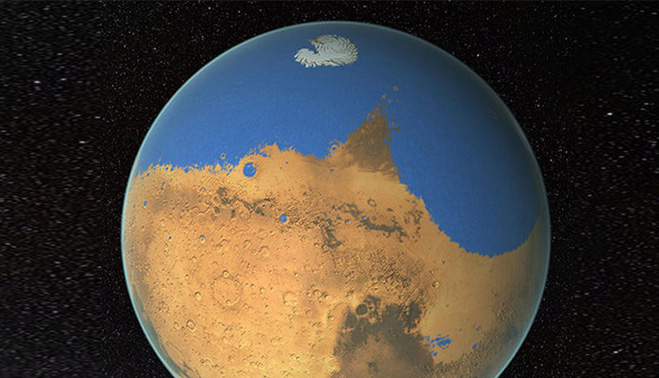![]() Home > Space & Science
Home > Space & Science
Did Asteroid Impacts Incubate Mars' Ancient Oceans?

Artist's impression of a primitive ocean on Mars, which one set of researchers suggested had more water than the Arctic Ocean on Earth. (Most of that water was later lost to space.) Credit: NASA/GSFC
![]() April 26th, 2016 | 10:17 AM |
April 26th, 2016 | 10:17 AM | ![]() 1906 views
1906 views
Space.com
Last year, NASA researchers looked at water in the Red Planet's atmosphere and compared it to water trapped in ancient meteorites from Mars. The research suggested that roughly 87 percent of the water escaped to space. But there's ample evidence out there that Mars was once soaked in water. For example: All three rovers that landed on the surface have found evidence of it in various forms — minerals formed in water, or ancient streambeds.
If an ocean did exist, it would be where the rovers are — in the northern plains, since it is low-lying ground. But how did that water get there in the first place?
An emerging hypothesis suggests that a few billion years ago, much of Mars was covered in water ice (similar to the poles of today). The ice likely came from asteroids depositing it on to the surface. Then came an event known as the Late Heavy Bombardment, where asteroid debris pummeled the inner solar system roughly four billion years ago. The asteroids could have melted the Martian ice and created an ocean for as long as 200 million years.
The research comes from Timothy Parker, a research scientist at NASA's Jet Propulsion Laboratory, who has researched the possibility of a past ocean on Mars since the 1980s. That's when the Viking missions were beaming back black-and-white images of Mars at what today would be considered extremely low resolution. Even then, Parker told Discovery News, he could see what he described as "wave-refracted shorelines" in the northern plains of Mars, shorelines that appeared similar to what is on Earth.
As better, more high-resolution data arrived in the 1990s and beyond, Parker noticed something odd. The supposed Martian ocean interiors are lower than the shorelines. This is opposite to what happened on Earth, when isostatic rebound (the ground rising up after large icebergs melt) made the interiors higher than the shorelines. What accounted for the mystery?
The new work on Mars focuses on Meridiani Planum, the region in which the Opportunity rover has been driving since 2003. Researchers have seen a lot of material associated with evaporation there — primarily sulfate (salt) deposits. From Earth observations (such as in the Bahamas), Parker says that to get that kind of deposition, you need to have a very shallow ocean just a few meters deep. This leads to concentrated water evaporation over a broad, shallow area, leaving behind expansive sulfate deposits.
Parker suggests that Mars did not natively have an ocean — it was too far from the sun and its atmosphere, even back then, was quite thin. Instead, he suggests that Mars was an ice-covered planet. The sulfates came from meteorites that hit the surface and temporarily melted the ice, forming a shallow pool of water.
"Once the Late Heavy Bombardment ceased, the ocean regressed and froze over," Parker said. That would explain the shorelines staying depressed, because the resulting ice didn’t evaporate rapidly as what was seen on Earth after ice ages; instead, it slowly sublimated into the Martian atmosphere.
He also pointed out that such an ocean would have been covered in debris and ice. At the shorelines, it would create channels that look like they were carved by thick lava (an alternate explanation for possibly water-carved channels on Mars).
Parker believes that Opportunity is driving on an ocean lakebed because of the number of large polygonal cracks it has encountered (implying massive evaporation). Also, some parts of Endeavour Crater (its current roving grounds) have damage, scour marks and the like that suggest ice being pushed around in vast quantities by water and hitting the shoreline. But his hypothesis is not universally accepted by the team, he added.
Another explanation for a liquid ocean could be the planet gradually outgassing volatiles through volcanism, but this depends on factors such as how thick the atmosphere was on Mars and how much sunlight the sun had to warm the planet. The general consensus was the young sun only had 70 percent the strength of the current one, so Parker said he isn't sure this alternate hypothesis is viable.
Parker presented his research at the Lunar and Planetary Science Conference in Texas in March. He said his goal is to get some discussion from the community, and to begin correlating the work with results from other missions such as NASA’s orbital MAVEN (Mars Atmosphere and Volatile Evolution) mission, which is investigating the mysteries of Mars’ thin atmosphere.
Source:
courtesy of SPACE
by Elizabeth Howell
If you have any stories or news that you would like to share with the global online community, please feel free to share it with us by contacting us directly at [email protected]